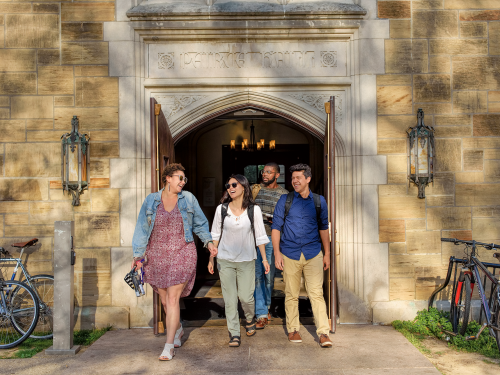Kenyon College has more financial aid because an anonymous offer is matching new contributions to permanent funding for need-based scholarships.
The $5 million challenge was issued for the College’s Our Path Forward comprehensive campaign, which publicly launched in October. So far, $2.15 million of the donor’s $5 million match has been used, and the most recent qualifying gift was pledged on the campaign’s kickoff weekend. Several other donors are in conversation with the College about taking advantage of the match.
The anonymous donor said, “To fulfill its mission, the College needs support from all alumni and friends of the College, especially from those with greater means. But after all, what are those means for if not to help the next generation? I am glad to support Kenyon and hope others will do so as well.”
Liz and Franklin Myers P’17 are among the contributors to the scholarship match. Liz Myers has worked for years to connect Houston students from disadvantaged backgrounds with top colleges in the nation.
“It was heartbreaking to see these bright students want to attend a small liberal arts school like Kenyon, where they knew they could get personal attention from great professors, yet their only options were large public universities,” she said. “These students were often uncomfortable taking on even minimal amounts of debt, fearing they could never afford to pay it back. I wanted to help close the financial gap so they could attend Kenyon, a school I love and respect.”
The new scholarship funding will help generations of students to come because the principal gift remains invested while contributing about 4.5 percent of its value to the College’s annual budget. Before the campaign began, such endowed funds covered only 12 percent of Kenyon’s annual financial aid spending.
Douglas Y. Wang ’78, a member of the Kenyon Board of Trustees, took the scholarship match because he sees census data that indicates College applicants in the future will be more ethnically diverse, be more likely the first in their families to attend college and be more in need of financial aid.
“In my class of 1978, there was one African-American and one other Asian-American, and that was it for our diversity. That is not sustainable if you want to be a world-class college with the best students,” Wang said. “It’s not actually that much of a problem if you have a fair amount of endowment funding to support a fair amount of scholarship. But it takes some investment now. Building endowment is the only long-term way a school like Kenyon can remain competitive.”
A third of the $300 million Our Path Forward campaign will be endowed funds for financial aid, and in its first three years the Kenyon community has added $41 million in endowed scholarship funding.
The anonymous donor is matching gifts that:
- establish a need-based scholarship with at least $250,000 in endowment
- add between $250,000 and $500,000 to an existing need-based scholarship
- add between $250,000 and $500,000 to the President’s Fund, a financial aid effort created last year by former Board of Trustees chair Barry F. Schwartz ’70, H’15.
For example, a contribution of $250,000 to a scholarship endowment that qualified for the $250,000 in matching funds would add $500,000 to Kenyon’s endowment and provide $22,500 more in financial aid each year.
Susan Scribner Mirza P’18 made a gift for the match. “The match is a very compelling part of it — to know that your gift is going to be doubled. My gift goes from $500,000 to $1 million of endowed funding, so the annual contribution from that will pay most of what it costs to attend Kenyon per year. My gift is sending one kid to college — and an excellent college like Kenyon.”
Financial aid is the fastest growing item in the College’s annual budget. It totaled more than $35 million in the 2017-18 fiscal year.
But the 10 colleges whose applicants also apply to Kenyon in the greatest numbers — peers such as Oberlin, Middlebury and Grinnell — all have endowments larger than Kenyon’s when measured per full-time student. Thus, those peer schools have more financial aid to dispense.
Former trustee David H. Cannon ’73 and his wife, Susan, also made a contribution that qualified for the match.
“Kenyon is an excellent liberal arts school in the middle of scenic, beautiful Ohio. It’s not in New York or Chicago or Los Angeles, so to get worldly and diverse students, you have to go get them with an extra effort. You have to try harder to do something about it,” he said.
“I hear the admissions office saying, ‘This was absolutely the candidate we wanted, but we lost them to another school that was able to offer them full scholarship.’ That’s baloney! As a student, I found Kenyon to be inspirational, I found it to be sensational, I found it to be motivational. So I get a bit of a competitive vibe about it. I want to jump into that wagon and hitch my resources to that effort to get great students.”
Former trustee Sam Fischer P’10 and his wife, Leah, have previously provided scholarships that helped Latina students attend Kenyon, and their new contribution for the match went to The President’s Fund and its goal of raising $20 million in endowed scholarship.
“It’s a simple question of resources. Kenyon is doing much better on financial aid, but it has a long way to go,” Sam Fischer said. “The scholarship match was certainly a factor in my gift, but a bigger factor was the leadership of President Sean Decatur and Barry Schwartz and my respect for both of them. The efforts of those gentlemen on this issue really motivated us.
